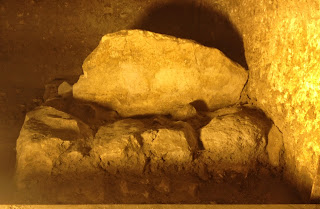What inspired these independent nations to collaborate against Israel? In absentia, Israel should not have deserved their collective, ill treatment or designation as enemy of their various states. Yet, they unanimously stood against Israel's attempt to reach its destination. The threat of Israel rising must have been a significant motivating factor that contributed to this coordinated national resistance.
If we use the Bible as a context, Israel's redemption from exile in Egypt must have seemed like the impossible come true. This fledgling nation of 70 had grown to an army of 600,000 men and now their families were amassed along the south eastern boundary of the Jordan River. The daunting prospect should have dampened the conviction of the alliance against Israel, yet each nation stood resolute against them.
This article is not about the war that ensued, during which Israel conquered the land of Moab, Amon and the Amorites east of the Jordan river instead it focuses on the ultimate destination, the mountain that motivated Israel's allied opponents to remain united and intransigent.
Some 300 years after these events, there was good reason King David waited for 7 years, after his inauguration, before he could advance on the mountain from which he would ultimately establish the united kingdom of Israel. The mountain, is ancient Jerusalem's Mount Moriah associated with some of Israel's most significant events during establishment, and post redemption from Egypt. Israel's preamble, as recorded in the Bible and commentaries preserved over multiple millennia include stories of, Adam, MalchiTzedek, Abraham, Isaac, Jacob, Joshua and, David followed by a 1000 year lineage of kings. So, why was conquering the mountain a go-no-go event for David and why did he risk his fragile kingdom to capture it?
To answer that I offer the following pictorial study of the early through late bronze age (4000-3300 years ago) artifacts that preceded King David (3000 years ago) on Mount Moriah.
| Inside cave home on the lower eastern slope of Mt Moriah |
 |
| Passage out of cave home, north to steel steps |
| Early bronze VIP pottery discovered by Parker
|
| Connection arrives at upper ridge altar and liquids channel |
 |
| Upper ridge - bedrock and steel cabinet |
| Standing stone/pillar or matzevah on upper ridge |
 |
| Oil press on upper ridge (north end) |
 |
| V-markings on upper ridge (animal processing - south end) |
 |
| Double walled fortress of Zion south of Gihon spring |
| View from upper ridge into the double wall fortress of Zion |
By the end of the Middle Bronze Age the massive double wall of the fortress of Zion was built up the steep eastern slope of Mount Moriah. It was an enormously complex feat of architecture and engineering for that time. It could not have been accomplished by the small local population alone. They must have obtained the full support of the alliance and there must have been a deeply rooted reason for allies to dedicate the resources required for its construction. The water of the adjacent Gihon Spring was not directly protected by its construction and could not have served as the reason for it.
| The ~2700 year old city wall can be seen in the upper section of this image on top of an older wall connected to the bedrock |
| Connect the blue plastic to piece together remnant of the southern element of the double wall fortress of Zion |
Apparently the allied forces opposing Israel did not want Israel to come back to the mountain and particularly this section on the south eastern slope. But, why did King David make sure to conquer this mountain, at this location in order to unify his kingdom?
The area was once known as Luz, Salem previous to that. It was the area that Malchi-Tzedek practiced as high priest, where Abraham tithed to him, where Isaac was offered as a sacrifice and Jacob erected the pillar, standing stone or matzevah. For these reasons Israel's allied enemies were intent on permanently isolating the bedrock temple discovered at this location and they did all they could to ensure the impracticality of its use. They allowed it to be buried under natural ground cover and defended against Israel's attempts to reoccupy the location. By the time King David conquered it, 300 years after Israel's return, the bedrock temple on the upper ridge was out of site, buried deep under ground. These are my opinions, I invite you to form yours!
The area was once known as Luz, Salem previous to that. It was the area that Malchi-Tzedek practiced as high priest, where Abraham tithed to him, where Isaac was offered as a sacrifice and Jacob erected the pillar, standing stone or matzevah. For these reasons Israel's allied enemies were intent on permanently isolating the bedrock temple discovered at this location and they did all they could to ensure the impracticality of its use. They allowed it to be buried under natural ground cover and defended against Israel's attempts to reoccupy the location. By the time King David conquered it, 300 years after Israel's return, the bedrock temple on the upper ridge was out of site, buried deep under ground. These are my opinions, I invite you to form yours!













